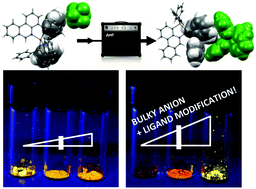Exploiting synergy between ligand design and counterion interactions to boost room temperature phosphorescence from Cu(i) compounds†
Abstract
The structural and photophysical properties of three sets of luminescent copper complexes of the form [(P^N)2Cu]X are presented. Here, P^N represents a bidentate ligand based on phenanthridine (3,4-benzoquinoline) incorporating a phosphine unit at the 4-position, of which three examples are investigated, namely 4-(diphenylphosphino)phenanthridine (L1), 4-(diphenylphosphino)-2-methylphenanthridine (L2) and 2,6-dimethyl-4-(diphenylphosphino)phenanthridine (L3). For each P^N-coordinating ligand, the corresponding homoleptic copper(I) complex (1X, 2X, 3X) has been prepared as both the hexafluorophosphate and tetraphenylborate salt (X = PF6− or BPh4−). The identity of the counterion has a profound and unexpected impact on the emission properties of the powder samples – but only for complexes of ligands bearing methyl substituents close to the metal (3X). The synergistic effect of combining inter-ion interactions and ligand design enables emission tuning from orange to yellow, in the opposite (hypsochromic) direction compared to employing either strategy on its own. These effects can be attributed to differences in molecular packing, in particular to the combined impact of ligand structure and inter-ionic interactions on distortions in the excited state relative to the ground state. The results have been interpreted with the help of density functional theory (DFT) and time-dependent DFT (TD-DFT) calculations.

- This article is part of the themed collection: Functional Organic Materials for Optoelectronic Applications


 Please wait while we load your content...
Please wait while we load your content...